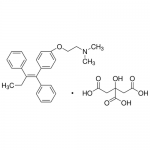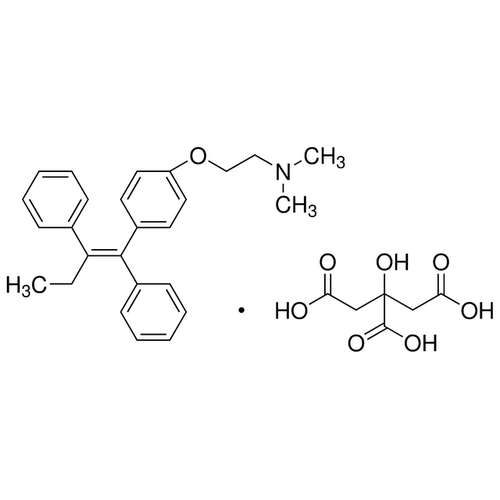| Product Name | Tamoxifen Citrate |
| Description |
Autophagy inducer |
| Purity | >99% |
| CAS No. | 54965-24-1 |
| Molecular Formula | C26H29NO•C6H8O7 |
| Molecular Weight | 563.65 |
| Field of Use | Not for use in humans. Not for use in diagnostics or therapeutics. For in vitro research use only. |
Properties
| Storage Temperature | -20ºC |
| Shipping Temperature | Shipped Ambient |
| Product Type | Inducer |
| Solubility | Soluble in methanol (50 mg/ml) or ethanol; very slightly soluble in water or acetone. |
| Source | Synthetic |
| Appearance | White to off-white powder |
| SMILES | C(C(O)(C(=O)O)CC(=O)O)C(=O)O.C3=C(C(=C(C1=CC=CC=C1)CC)C2=CC=CC=C2)C=CC(=C3)OCCN(C)C |
| InChI | InChI=1S/C26H29NO.C6H8O7/c1-4-25(21-11-7-5-8-12-21)26(22-13-9-6-10-14-22)23-15-17-24(18-16-23)28-20-19-27(2)3;7-3(8)1-6(13,5(11)12)2-4(9)10/h5-18H,4,19-20H2,1-3H3;13H,1-2H2,(H,7,8)(H,9,10)(H,11,12)/b |
| InChIKey | FQZYTYWMLGAPFJ-OQKDUQJOSA-N |
| Safety Phrases |
Classification: D2A- Very Toxic Material Causing Other Toxic Effects, Teratogen, Carcinogen, Reproductive hazard Safety Phrases: S22 - Do not breathe dust. S24/25 - Avoid contact with skin and eyes. S36/37/39 - Wear suitable protective clothing, gloves and eye/face protection. Hazard statements: H302- Harmful if swallowed. H350- May cause cancer. H360- May damage fertility or the unborn child. Precautionary statements: P201- Obtain special instructions before use. P308 + P313- IF exposed or concerned: Get medical advice/ attention. |
| Cite This Product | Tamoxifen Citrate (StressMarq Biosciences Inc., Victoria BC CANADA, Catalog # SIH-389) |
Biological Description
| Alternative Names | (2)-2-[4-(1,2-Diphenyl-1-butenyl)phenoxy]-N,N-dimethylethanamine citrate |
| Research Areas | Autophagy, Cancer |
| PubChem ID | 2733525 |
| Scientific Background | Tamoxifen Citrate is a selective estrogen receptor modulator (SERM) primarily used in breast cancer therapy. In neuroscience, Tamoxifen has gained attention for its ability to modulate estrogen signaling in the brain, which influences neuroprotection, synaptic plasticity, and cognitive function. Estrogen receptors are expressed in various brain regions, and their activation has been linked to reduced neuroinflammation and oxidative stress. Tamoxifen also exhibits estrogen receptor-independent effects, including inhibition of protein kinase C, which may influence neuronal signaling pathways. Furthermore, Tamoxifen is widely used in inducible Cre-loxP systems for conditional gene knockout studies in neuroscience, enabling precise temporal and spatial control of gene expression in the brain. Its role in autophagy and cellular stress responses adds to its relevance in neurodegenerative disease models. |
| References |
1. Thomas, S. et al. (2011). Breast Cancer Res Treat, 130(2): 437-47. 2. Ma, J. et al. (2014). BMC Cancer, 14: 172. 3. Patel, S. et al. (2012). Int J Radiat Oncol Biol Phys, 82(2): 739-42. 4. Wang, D. et al. (2004). Mol Endocrinol. 402-11. |



Reviews
There are no reviews yet.